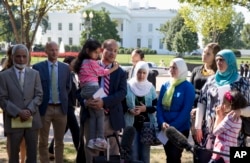Following a surge in Syrian refugee admissions in the last three months, the United States is on track to meet the Obama administration's goal of welcoming 10,000 Syrians by the end of September.
From Oct. 1, 2015, through Aug. 4 of this year, 8,004 Syrian refugees who fled violence and persecution in their home country have been resettled in the U.S.; half are under the age of 14, according to data from the State Department’s Refugee Processing Center.
Juliane Ramic, senior director for refugee and community integration for the Nationalities Service Center in Philadelphia has worked increasingly with Syrian children in recent months.
“We had these Little Debbie cookies and a seven year old boy motioned at me to put his hand out – I thought he was going to give me a high five, but he puts his cookie back in my hand and closes my fingers over it,” Ramic told VOA. “His mother said ‘you are his first friend and he wants to thank you’”
“It’s so striking because when I look at their age and what’s happened in Syria – all they’ve known is war and flight.”
Migration slow, but steady
With arrivals in the low hundreds every month, the target number was in doubt for much of the last seven months since U.S. Secretary of State John Kerry announced the new plan in September, calling into question whether the sixfold increase over the previous year’s total (1,682) could actually be met by the end of the current fiscal year.
In February, the State Department established what it called a refugee “resettlement surge center” in Amman, Jordan. While the paperwork, interviews, medical and security screenings for refugees usually take 18 to 24 months, American officials claimed the center could reduce the processing time to three months.
Beginning in May, refugee arrival data shows that the number of Syrians increased from the hundreds in previous months to 1,069 in May; it then topped 2,000 in June and July.
"What we know is that more resources have been put toward the processing of folks who have been pending," Stacie Blake, spokesperson for the U.S. Committee for Refugees and Immigrants told VOA. "More resources obviously meant that more folks were able to move through the system."
While processing centers abroad have more recently increased their capacity to resettle refugees, many affiliates in American cities have been preparing to receive them. Affiliates such as the Nationalities Service Center in Philadelphia have submitted yearly reports to the U.S. State Department on the number of refugees they are able to accommodate, as well as why their city would be a welcoming new home, Ramic told VOA.
"We proactively tell … the State Department that Philadelphia would be a welcoming community for Syrians and why," Ramic said. "There's a very small but existing Syrian community, and it's just over an hour from Allentown – the largest community of Syrians in the country."
The roughly 8,000 Syrian refugees who arrived this fiscal year were placed in 38 states: With 887 arrivals, Michigan was the top recipient, followed by California (783), Arizona (651), Texas (565) and Pennsylvania (481).
The U.S. is the largest recipient of third-country resettlement in the world; 60,921 refugees have arrived since last October.
Cap increased to 85,000
Last year, Kerry also announced that the administration was increasing the cap on the total number of refugees allowed into the U.S. in the current fiscal year from 70,000 to 85,000. That number, which the president sets based on State Department recommendations, will rise to 100,000 in the coming year.
But the surge in Syrian refugees to the U.S. still falls short of the demand. The United Nations High Commissioner for Refugees (UNHCR) estimates 4.8 million Syrians have fled to Turkey, Lebanon, Jordan, Egypt and Iraq. Another 6.6 million have been displaced inside Syria.
Not all of those refugees will need to be resettled in a third country, however. Refugees are eligible for third-country resettlement when they cannot return to their home country or settle permanently in the country where they first sought asylum, often neighboring countries like Jordan for the Syrians.
Early in the Syrian civil war, which began in 2011, the U.S. was accepting only dozens of Syrian refugees a year. Neighboring countries like Lebanon, Jordan and Turkey have taken in millions fleeing internal conflict and the rise of Islamic State violence across the country.
The Obama administration’s call to accept more Syrian refugees was met with swift backlash from Republican governors across the country, and several state legislatures have introduced bills to curb the resettlement of some or all refugees from within their borders. Opponents to the increased refugee cap and additional Syrians argue that security screenings for refugees are inadequate, an allegation the administration has regularly refuted.
An Associated Press-GfK poll conducted in early July showed that 69 percent of Republicans say they favor a temporary ban on Muslim immigration. Overall, Americans opposed such a ban by a margin of 52 to 45 percent.
The U.N. General Assembly is holding a summit in September to address refugees and migrant issues, including nearly a million Syrians seeking asylum in Europe.











